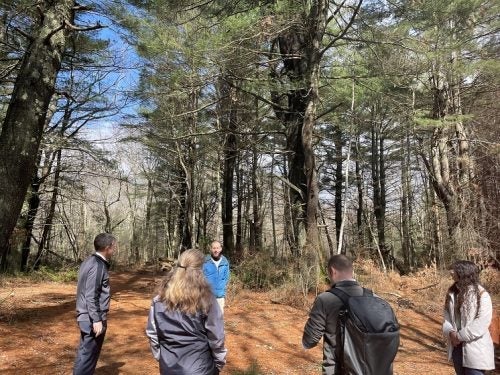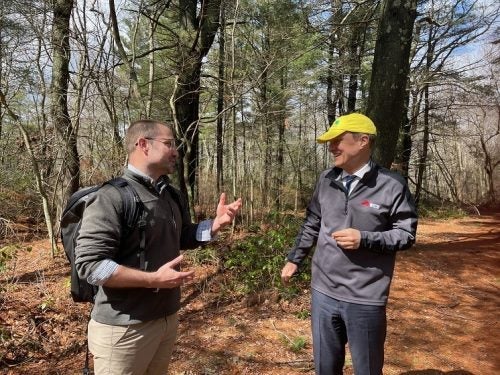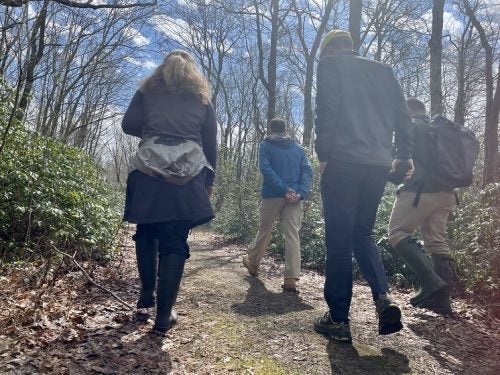Gabrielle Pezich and Dr. Michelle Peach show President Parlange and Karlo Berger frog eggs found in a vernal pool in the North Woods. Credit: Hannah MacDonald
By Hannah MacDonald, CELS Communication Fellow
Just north of Flagg Road, adjacent to URI’s Kingston campus, lies the North Woods encompassing over 300 acres of forest, wetlands, headwater streams, and robust trails. This area of land has captured the attention of a group of Masters of Environmental Science and Management (MESM) students to lead the North Woods Stewardship Project. Beginning in 2020, the project is a student-run initiative to responsibly steward, manage, and identify how the North Woods can best meet the University’s diverse academic and sustainability goals. The group was inspired to coordinate this project because of the North Woods connection to diversity. Diversity in the sense of the ecosystems, flora, and fauna within, the diversity of students and programs at the university, and the diversity of the opportunities to connect with nature in the North Woods.
“What students don’t necessarily realize is that there is something in North Woods for everybody,” remarks communications and student engagement coordinator, Chistina DiCenzo. The North Woods is currently used by many students as a learning lab for biology courses, a training space for the ROTC for leadership building with an obstacle course, and a trail system for walking or running. “There are so many ways people can use the woods and capitalize on different aspects to match their needs,” says DiCenzo. Her work in communications for this project emphasizes that no matter your background, the North Woods can be a resource for you on campus. DiCenzo was drawn to support this project from her time as an undergraduate at URI where she studied botany, radiotelemetry, and other field courses in the woods. She also mentions the aesthetic and spiritual importance of the North Woods with its proximity to campus. “It’s important to me that students continue to have amazing experiences in the North Woods and that the woods continue to enrich campus,” remarks DiCenzo. To her point, EcoRI News recently published an article about how being outside helps with stress reduction, mental health, and even focus, making the North Woods of even more importance to university students trying to catch their breath in nature or find some quiet among their busy studies.

Karlo Berger managed the project in 2021 and led the efforts for the preliminary report which showed that the North Woods is a diverse and underutilized region that the university should capitalize on for conservation and stewardship purposes. Berger coordinated the effort to collect information from URI faculty on biota, invasive species, area history, native American history, and mapping information. He also did demographic research on who was using the North Woods with a QR code survey on the trailheads. Information in this report will be used to guide the group in the stewardship and use of the area. Research on the value of university forests shows that they have critical benefits, including opportunities for hands-on education; research sites for a wide range of scholars; opportunities for recreation; spaces to demonstrate new techniques in forest management; and a host of other benefits that often goes unrecognized by administrative leadership (Coleman et al, 2020).
“Many higher education institutions don’t emphasize the importance of campus natural resources and adjacent lands in their sustainability initiatives,” says Gabrielle Pezich, the current program manager. “I see that as a huge missed opportunity since these areas promote student engagement in natural areas stewardship activities and contribute to the university’s broader academic and sustainability goals.” Pezich also emphasized that her studies in the North Woods through various courses can lead to more information that supports the management of the area in the future. This link of experiential learning in the North Woods, to its management, emphasizes the importance of the woods as a teaching asset to the university.

“One of the best aspects of the North Woods Stewardship Project is that it is a training opportunity for MESM students,” remarks Berger. “I wanted to get experience in environmental leadership and this was a great opportunity for me to do that.” Berger sees this project truly woven into the MESM approach of granting students the opportunity for experiential learning with communication, conservation, and stewardship of natural resources. “I think that for universities in the 21st century their biggest area for growth is in understanding, rearticulating, and redefining our relationship with the natural world,” explains Berger, “In that way, I see the North Woods as the perfect place for interdisciplinary and transdisciplinary thinking.”
The group emphasized the importance of this project in their own learning from their opportunity to do research during the preliminary report process, to their outings completing survey work, to the leadership skills they have built while coordinating the project. “Working with a group of like-minded graduate students has been helpful for me as I have been able to learn from them in the same way that I hope they can learn from me,” remarks Pezich. “This project has been the highlight of my URI experience,” states Berger.

You can meet members of the North Woods Stewardship Project on April 20th at the Earth Day on the Quad event from 10:00am to 3:00pm to learn more about their work and the future of the project. The group is also hosting a clean-up event in the North Woods for Earth Day on Saturday, April 23rd at 10:00am. Stay tuned to CELS social media for more information on how to attend. If someone is interested in getting involved in the North Woods Stewardship Project you can reach out to Dr. Peach at michelle_peach@uri.edu.
References
Coleman, Kimberly J.; Perry, Elizabeth E.; Thom, Dominik; Gladkikh, Tatiana M.; Keeton, William S.; Clark, Peter W.; Tursini, Ralph E.; Wallin, Kimberly F. 2020. The Woods around the Ivory Tower: A Systematic Review Examining the Value and Relevance of School Forests in the United States. Sustainability. 12(2): 531. 16 p. https://doi.org/10.3390/su12020531.
